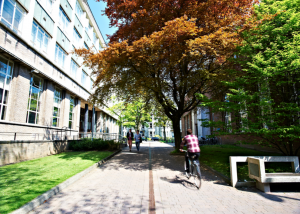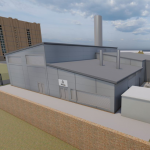Covid-19 unquestionably dominated 2020 – the year that was once predicted to be one of climate action – and while optimism is generally at its peak at the start of any new year, 2021 really could offer the turning point we need to achieve net zero emissions by 2050.
Since the legislation of the UK-wide climate target, we have seen a suite of announcements from businesses, local authorities and institutions declaring emergencies and pledging their own net zero commitments, many of which are decades in advance of 2050.
 Universities are among those to have set progressive targets; however, ‘most are still aligned to the old sector target of an 80% reduction of 1990 levels by 2050 [i],’ says Zamzam Ibrahim, President of the NUS and SOS-UK. With regards to addressing sustainability issues, 94% of students wish to see universities do more to be environmentally sustainable [ii]. There is not only a need to lower emissions and reduce costs but also to showcase the actions universities are taking to tackle climate change. Meeting net zero ambitions will require carbon emissions reduction plans that go much further than they have before, drawing on solutions that address and overcome the challenges universities face today while unlocking opportunities for the future.
Universities are among those to have set progressive targets; however, ‘most are still aligned to the old sector target of an 80% reduction of 1990 levels by 2050 [i],’ says Zamzam Ibrahim, President of the NUS and SOS-UK. With regards to addressing sustainability issues, 94% of students wish to see universities do more to be environmentally sustainable [ii]. There is not only a need to lower emissions and reduce costs but also to showcase the actions universities are taking to tackle climate change. Meeting net zero ambitions will require carbon emissions reduction plans that go much further than they have before, drawing on solutions that address and overcome the challenges universities face today while unlocking opportunities for the future.
One key challenge is that most universities have their own centralised energy systems which date back to the 1980s, meaning that campus heating infrastructure is often old and inefficient. With high population density and predictable high heat demand, university campuses are well placed to benefit from heat networks, otherwise known as district heating.
Heat networks form a key part of the UK’s transition to net zero emissions by 2050 and are particularly suited to high density areas such as a university campus. They supply heat from a central source through a series of insulated pipes carrying hot water, removing the need for each individual building to generate its own heat on site and subsequently unlocking larger-scale, renewable and recovered heat sources. With the ability to heat a few small buildings or an entire city, heat networks are recognised as a cost-effective way to provide reliable, low carbon heating. They could play a strategic role in university carbon emission reduction plans whilst delivering wider benefits. The development of a heat network on campus, for example, could benefit those inside and outside the university community, extending over time to provide low carbon heat to businesses and homes off-campus.
£320 million of investment in heat network schemes is being delivered through the Heat Networks Investment Project (HNIP), first launched in 2018 by the Department for Business, Energy, and Industrial Strategy. This large-scale investment is essential to the Government’s ambition to grow and develop a heat network market that thrives long term. The scheme, now in its third and final year, will continue to offer gap funding through a competitive application process and invites universities, and other eligible applicants, to engage with the scheme at the earliest opportunity.
 Newcastle University was the first university to be awarded funding through HNIP last year after securing a £2,900,000 loan to support the extension and upgrade of an existing district heat network on its city centre campus [iii]. Last year, Newcastle University established a new Centre for Energy to unify efforts across industry, policy, and academia in an effort to bring about a transition to clean, affordable energy and new ways of thinking about energy systems. A drive for emissions reduction is reflected in the University’s approach to heating its buildings; the project will replace the current gas boilers with a new liquid biofuel combined heat and power plant (CHP) which will deliver substantial carbon savings across the site.
Newcastle University was the first university to be awarded funding through HNIP last year after securing a £2,900,000 loan to support the extension and upgrade of an existing district heat network on its city centre campus [iii]. Last year, Newcastle University established a new Centre for Energy to unify efforts across industry, policy, and academia in an effort to bring about a transition to clean, affordable energy and new ways of thinking about energy systems. A drive for emissions reduction is reflected in the University’s approach to heating its buildings; the project will replace the current gas boilers with a new liquid biofuel combined heat and power plant (CHP) which will deliver substantial carbon savings across the site.
HNIP provides funding by way of grant and loans and can be combined with other funding sources to support sustainability objectives. Unlike the Public Sector Decarbonisation Fund which recently closed, HNIP is still accepting applications. Projects need to have drawn down and committed funding by March 2022; however, construction can be completed after this date so if you are already considering decarbonising university buildings, please get in touch.
The Government’s quarterly heat network pipeline includes several schemes which expect to connect to university buildings and schemes initiated and developed by ambitious universities themselves [iv]. It is expected that other university campus projects will come forward this year for HNIP funding as part of plans to transition to clean, affordable heating. With almost 1500 heat network connections in the UK [v] and an increasing interest in this low carbon, technology agnostic solution, it is clear that heat networks have an important role to play in reducing emissions both on and off campus.
For more information about the Newcastle University heat network scheme, click here.
For more information about HNIP, click here.
[i] https://www.theguardian.com/education/2020/aug/21/all-universities-must-commit-to-net-zero-by-2030-tackling-campus-climate-crisis
[ii] https://www.qs.com/portfolio-items/sustainability-in-higher-education/?utm_source=website&utm_medium=blog&utm_campaign=Sustainable2020
[iii] https://tp-heatnetworks.org/innovative-low-carbon-projects-in-north-east-secure-hnip-funding/
[iv] https://www.gov.uk/government/publications/hndu-pipeline
[v] https://www.theade.co.uk/resources/what-is-district-heating



